Stuffed Pasta Recipes
By lorik
Ingredients
- Basic Pasta Dough:
- 3-1/4 to 3-1/2 cups all-purpose flour
- 4 large eggs, at room temperature
- Pasta Imbottita (Stuffed Cheese Pillows in Broth):
- Serves 6
- 3-1/2 oz. ricotta
- 3-1/2 oz. stracchino or quark
- 2 oz. Parmigiano Reggiano, grated, plus more for garnish
- Pinch of freshly grated nutmeg
- 1 Tbs. lemon zest
- 1 large egg
- Kosher salt
- Freshly ground black pepper
- 1 recipe basic pasta dough
- 1 quart homemade chicken broth or canned low-sodium broth
- Raviolo Bergese (Egg-Yolk Raviolo):
- Serves 12
- 6 oz. spinach
- 10 Tbs. unsalted butter
- Kosher salt
- Freshly ground black pepper
- 8 oz. ricotta
- 1/4 cup grated Parmigiano Reggiano, plus more for garnish
- 1/4 tsp. freshly grated nutmeg
- 1 tsp. lemon zest
- 1 recipe Basic Pasta Dough
- 12 jumbo egg yolks, egg whites reserved
- Beet and Blue Cheese Ravioli:
- Serves 4
- For the Ravioli dough:
- 7 oz. (1-1/3 cup plus 2 Tbs.) 00 flour; more as needed
- 1-3/4 oz. (1/4 cup plus 1 Tbs.) semola rimacinata (fine flour) or unbleached all-purpose flour
- 6 large egg yolks
- 1 large egg
- 1-1/2 tsp. extra-virgin olive oil
- 1/4 tsp. kosher salt
- For the filling:
- 3/4 lb. red beets, well washed (about 5 small)
- 3 Tbs. extra-virgin olive oil
- 4 sprigs fresh thyme
- 1 bay leaf
- Kosher salt and freshly ground black pepper
- 3 oz. (2/3 cup) Gorgonzola
- 1-1/2 oz. (2-1/2 Tbs.) mascarpone
- For cooking and serving
- Kosher salt
- 4 oz. (1/2 cup) unsalted butter
- Chopped parsley, for garnish (optional)
- Goat Cheese Ravioli with Asparagus and Brown Butter:
- Serves 4
- For the filling
- 1 lb. fresh goat cheese, at room temperature
- 1/2 tsp. finely chopped garlic
- 1 Tbs. dry white wine
- 2 tsp. extra-virgin olive oil
- Grated zest of 1 lemon
- 1/2 cup finely chopped mixed fresh herbs (try any combination of flat-leaf parsley, tarragon, chervil, cilantro, thyme, basil, chives, or mint)
- 1 Tbs. fine fresh breadcrumbs
- Salt and freshly ground black pepper to taste
- 1 lb. Ravioli Pasta Dough (See above)
- 1 large egg yolk, lightly beaten
- Semolina flour or fine cornmeal to dust the pan
- For the sauce:
- 1/4 lb. (8 Tbs.) unsalted butter
- Salt to taste
- 1/2 lb. asparagus, parboiled for 1 to 2 min. until tender, and cut into 1-inch pieces
- 2 Tbs. freshly grated Parmesan cheese, preferably parmigiano reggiano, for garnish
- Chervil, parsley, or basil sprigs for garnish
Details
Adapted from finecooking.com
Preparation
Step 1
Pasta Directions:
Make a well with the flour and add the eggs to the center. With a fork, lightly beat the eggs and gradually pull some of the flour into the egg mixture. Mix the flour and eggs together until well combined. Knead the dough until it becomes smooth and elastic.
Cover the dough with a towel and let rest for 20 minutes.
Cut the dough into 6 pieces and cover with a towel. Pass one section at a time through a pasta machine. Start on the widest setting and pass the dough through. Begin lowering the machine’s setting down one notch at a time, and pass the dough through once on each setting, finishing on the last (thinnest) setting.
Lay the dough on a flat surface sprinkled lightly with flour and let the dough dry slightly. It should still be a little tacky and pliable, or it will not cut properly. Cut the dough into desired shapes
Pasta Imbottita:
In a large bowl, mix together the ricotta, stracchino, Parmigiano Reggiano, nutmeg, lemon zest, and egg until thoroughly combined.
On a clean work surface lightly dusted with flour, roll out the pasta dough into an 18-inch circle 1/8 inch thick. Spread a thin layer of the cheese filling over the bottom half of the dough. Fold the top half of the dough over the filling to form a half moon. With a handheld pasta cutter, cut the dough into long vertical strips 1/2 inch wide. Then cut horizontally every 1/4 inch to make small rectangles.
Place the stuffed pillows on a lightly floured sheet pan. Place in the freezer at least 1 hour prior to cooking.
In a 6-quart pot, bring the chicken broth up to a boil. Add 2 Tbs. salt. Drop the pasta into the broth and gently simmer until tender. Ladle the soup into shallow bowls and serve with pepper and grated Parmigiano Reggiano.
Raviolo Bergese:
Remove the tough stems from the spinach and clean by rinsing in cold water. In a 12-inch sauté pan over medium heat, melt 2 Tbs. of butter; add the spinach and cover to wilt, 3 to 5 minutes. Remove the cover and let the spinach dry out a little, then season with 1/2 tsp. salt and 1/4 tsp. pepper.
In the bowl of a food processor, combine the ricotta, Parmigiano Reggiano, nutmeg, lemon zest, spinach, and a pinch of salt and pepper, and puree until smooth. Fill a pastry bag fitted with a round tip with the ricotta mixture.
Divide the dough into 4 pieces. Using a pasta machine, roll the dough out, starting at the widest setting and ending with the second-thinnest setting. Lay out one sheet of pasta and pipe the ricotta mixture into circles on the dough, 1 inch wide and 1/2 inch tall. Place one egg yolk in the center of each ricotta circle. With a pastry brush, brush egg white onto the dough around the filling, being careful not to break the yolk. Press the dough together and make sure to remove all air from inside. Cut out the ravioli with a round fluted cookie cutter.
Bring 6 quarts of salted water to a soft boil. Working 3 or 4 at a time, gently place the ravioli in the boiling water, cook for 3 minutes, and then remove with a slotted spoon. Repeat for the remaining ravioli. Reserve 1/4 cup of the pasta water.
In a 2- or 3-quart saucepan, melt the remaining 8 Tbs. butter until it begins to foam. Whisk in the reserved pasta water and cook for 1 minute to emulsify the liquids.
Place one raviolo on each individual plate, drizzle with the butter sauce, and sprinkle with grated Parmigiano Reggiano. Serve immediately.
Beet and Blue Cheese Ravioli:
Make the dough:
Dump the flours on a work surface and mix to combine them. Make a deep, wide well in the center, making sure there is some flour on the bottom so the eggs are not directly on the surface. Add the egg yolks, whole egg, oil, and salt.
Using a fork, beat the wet ingredients until combined, staying in the center and being careful that the eggs don’t breach the wall. (If any does, gather it up and reinforce the wall.)
Begin mixing in the flour from the inside of the wall, a little at a time, until the dough is too stiff to mix with the fork. Scrape the dough off the fork and continue mixing by hand, folding it and forming it into a single mass. If necessary, use a bench scraper to move the dough and to scrape any dried bits to the side.
Lightly flour the work surface and knead the dough for at least 5 minutes, adding more flour if needed to keep the dough from sticking to your hands. Continue kneading until the dough is a smooth ball that feels soft like your earlobe. Wrap the dough loosely in plastic and refrigerate for at least 1 hour. (Let it warm up a little before rolling, if necessary.)
Prepare the filling:
Position a rack in the center of the oven and heat the oven to 375°F.
Put the beets in an 8x8-inch baking dish and toss with the olive oil. Add the thyme, bay leaves, and 1/2 cup water. Season with salt and pepper and cover tightly with foil. Roast until easily pierced with a fork, about 1 hour.
Cool in the baking dish for 15 minutes. Peel the beets and transfer to a blender or food processor. Strain the liquid through a fine-mesh strainer and reserve.
Pulse the beets into a thick purée, adding a little of the reserved cooking liquid, if necessary. Transfer to a medium bowl and mix with the Gorgonzola and mascarpone. Season to taste with salt and pepper. Cover and refrigerate for up to 2 days.
Roll the dough:
Set up a pasta machine on a large work surface. Set the machine to its widest setting.
Flatten the dough with your hand or a rolling pin and divide it into pieces. (If you’re comfortable rolling dough, in half is fine; otherwise divide it into 3 or 4 pieces to get shorter sheets.)
Working with one piece at a time and keeping the other pieces wrapped in plastic or a cloth, run the dough through the widest setting on the machine a couple of times, flouring as needed, to work the dough.
Move the rollers to the next setting and pass the dough through. Continue notching down by one setting and passing the dough through each time. Stop rolling when you can see the outline of your hand thorough the dough; this may not be the thinnest setting on some machines.
Cut the sheet crosswise into 2-foot lengths to make them easier to work with and trim the long sides to make neat rectangles. (If you need to stack them, very lightly flour them.) Cover loosely with plastic wrap or a clean kitchen towel. Repeat with the remaining pieces of pasta.
Make the ravioli:
Lightly flour a rimmed baking sheet or tray.
Working with one pasta sheet at a time, very lightly moisten the entire strip with water using a spray bottle or a pastry brush.
Spoon rounded teaspoonfuls of the filling 1 inch apart along the center of the sheet. Lift the top edge of the strip and bring it down to meet the bottom, letting it fall loosely over the filling and lining up the edges. Using your fingers, gently press on the dough close to each mound to coax out any trapped air, and then press on the edges to seal completely.
Using a fluted pastry wheel or a knife, trim the long, unfolded edge of the ravioli if you like. Then cut the pasta between the mounds to form individual ravioli. Transfer the ravioli to the prepared baking sheet in a single layer. Repeat with the remaining dough and filling. You can cook the ravioli right away or cover and refrigerate for up to a day (you can also freeze them; see Make-Ahead Tip, below).
Cook and serve the ravioli:
When ready to serve, bring a pot of well-salted water to a boil. Gently slide the ravioli (fresh or frozen) into the water and cook until tender, 3 to 5 minutes.
Meanwhile, melt the butter along with 1/4 cup of the pasta cooking water in a skillet or saucepan over medium-low heat. Whisk to emulsify and season to taste with kosher salt.
Use a skimmer to remove the ravioli from the water as draining them in a colander can damage them. Serve the ravioli with the butter sauce, garnished with parsley, if you like.
Make Ahead Tips:
The dough can be refrigerated, wrapped in plastic, for up to 2 days before rolling and shaping the ravioli.
The filling can be refrigerated, covered, for up to 2 days.
The uncooked ravioli can be frozen for up to a month: freeze them uncovered on their tray until rock hard, then transfer to zip-top bags and return to the freezer. There's no need to thaw them before cooking.
Goat Cheese Ravioli:
To make the filling:
Put the goat cheese in a mixing bowl. Add the garlic, wine, olive oil, and lemon zest. Mash the cheese with a whisk or a rubber spatula. Stir in the chopped herbs and breadcrumbs. Season with salt and pepper. Refrigerate until ready to use.
To roll out and stuff the pasta dough:
Divide the ravioli dough into four equal pieces. Wrap three in plastic and return to the refrigerator. Flatten the fourth piece of dough with your hand (flour it lightly if necessary), and run it through the widest setting on your pasta machine twice. Set the rollers to the next narrower setting. Pass the dough through twice. Continue notching down by one setting and passing the dough through two times (the first pass roughs up the dough; the second pass smooths it out).
As the dough lengthens and thins, it will bunch up under the machine. Rectify this by gently lifting it out and folding it neatly behind the machine. When you can just see the shape and shadow of your hand through the dough sheet (it should be about 1/32 inch thick), stop rolling. You may not need to go to the narrowest setting.
Cut the sheet in half crosswise and trim the sides to make two neat rectangles, one slightly larger than the other. On the smaller sheet, spoon mounds of 1 to 2 tsp. of filling, leaving 1/2 to 3/4 inch between each mound. (For smaller ravioli, use less filling in each mound and space them more closely; for larger ravioli, use more.) Brush a little beaten egg yolk on the dough around each mound of filling.
Lay the second sheet of dough on top, draping it gently over the mounds without stretching it. Starting at one edge, gently press around the filling to push out any air pockets and seal the sheets.
Cut the pasta in between the mounds to form individual squares or circles with a scalloped pastry wheel or ravioli stamp (if you don't have either of these, try a biscuit cutter or a paring knife). Press on the mounds a bit to slightly flatten them and on the edges to confirm the seal. Roll out, fill, and cut the remaining dough the same way.
To make the sauce and finish the pasta:
When ready to serve, bring a pot of salted water to a boil. Gently slide the chilled or frozen ravioli into the water and cook until they float and are tender, 3 to 5 minutes.
Meanwhile, melt the butter in a saucepan over medium heat, whisking occasionally, until the butter solids turn a light brown. Season with salt and add the asparagus.
Drain the ravioli and toss with the asparagus and brown butter. Spoon onto a large serving platter or individual plates, sprinkle with the Parmesan, garnish with the herb sprigs, and serve.
Make Ahead Tips:
The filling can be made up to two days ahead. Filled, uncooked ravioli can be refrigerated for up to a day or frozen, wrapped, for up to a month. If you're not cooking them right away, transfer them to a pan lined with waxed paper and sprinkled with semolina flour or cornmeal (don't let them touch) before refrigerating or freezing.
Leftovers:
If you have extra goat cheese filling, try it on a sandwich with roasted peppers.
You'll also love
-
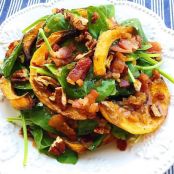 Crispy Butternut Squash Spinach...
3.9/5
(12 Votes)
Crispy Butternut Squash Spinach...
3.9/5
(12 Votes)
-
 Blender Banana Oatmeal Muffins
4.7/5
(9 Votes)
Blender Banana Oatmeal Muffins
4.7/5
(9 Votes)
-
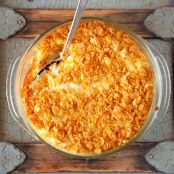 Sweet Noodle Kugel, Lokshen Kugel
4.7/5
(7 Votes)
Sweet Noodle Kugel, Lokshen Kugel
4.7/5
(7 Votes)
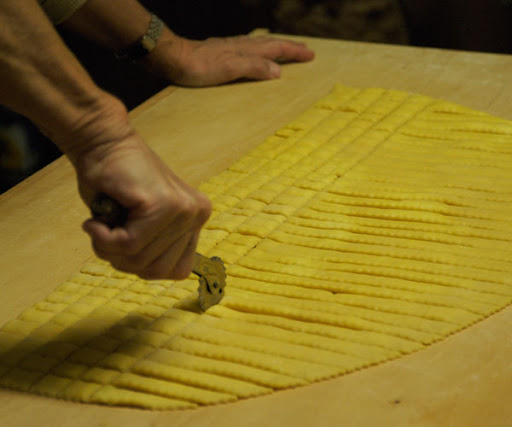
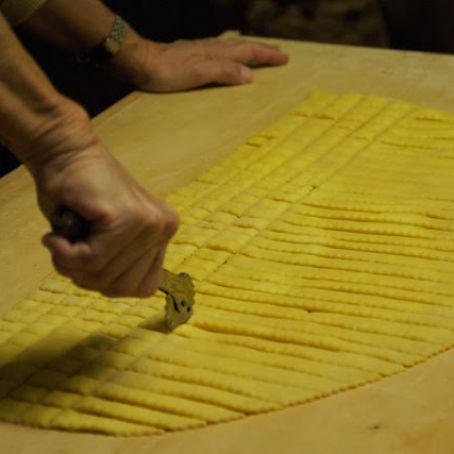
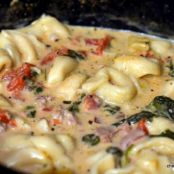
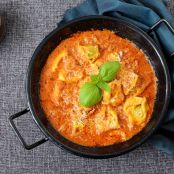
Review this recipe